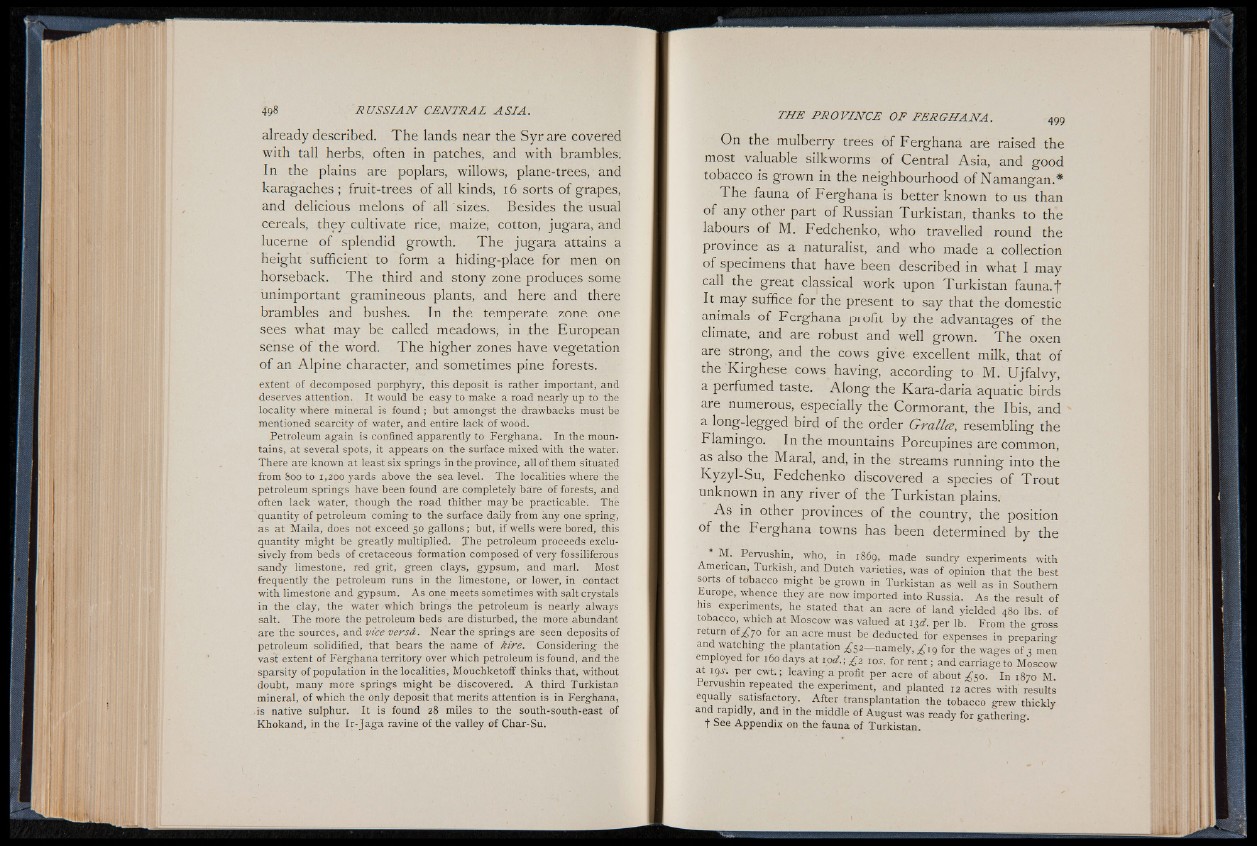
already described. The lands near the Syr are covered
with tall herbs, often in patches, and with brambles.
In the plains are poplars, willows, plane-trees, and
karagaches ; fruit-trees of all kinds, 16 sorts of grapes,
and delicious melons of all sizes. Besides the usual
cereals, they cultivate rice, maize; cotton, jugara, and
lucerne of splendid growth. The jugara attains a
height sufficient to form a hiding-place for men on
horseback. The third and stony zone produces some
unimportant gramineous plants, and here and there
brambles and bushes. In the temperate zone one
sees what may be called meadows, in the European
sense of the word. The higher zones have vegetation
o f an Alpine character, and sometimes pine forests.
extent of decomposed porphyry, this deposit is rather important, and
deserves attention. It would be easy to make a road nearly up to the
locality where mineral is found ; but amongst the drawbacks must be
mentioned scarcity of water, and entire la ck of wood.
Petroleum again is confined apparently to Ferghana. In the mountains,
at several spots, it appears on the surface mixed with the water.
There are known at least six springs in the province, all of them situated
from 800 to 1,200 yards above the sea level. The localities where the
petroleum, springs have been found arê completely bare of forests, and
often lack water, though the road thither may be practicable. Thé
quantity of petroleum coming to the surface daily from any one spring,
as at Maila, does not exceed 50 gallons ; but, if w ells were bored, this
quantity might be greatly multiplied. The petroleum proceeds exclusively
from beds o f cretaceous formation composed of very fossiliferous
sandy limestone, red grit, green clays, gypsum, and marl. Most
frequently the petroleum runs in the limestone, or lower, in cpntact
with limestone and gypsum. A s one meets sometimes with salt crystals
in the clay, the water which brings the petroleum is nearly always
salt. The more the petroleum beds are disturbed, the more abundant
are the sources, and vice versâ. Near the springs are seen deposits of
petroleum solidified, that bears the name of kire. Considering the
vast extent of Fèrghana territory over which petroleum is found, and the
sparsity of population in the localities, Mouchketoff thinks that, without
doubt, many more springs might be discovered. A third Turkistan
mineral, of which the only deposit that merits attention is in Ferghana,
is native sulphur. It is found 28 miles to the south-south-east of
Khokand, in the Ir-Jaga ravine of the valley of Char-Su.
On the mulberry trees of Ferghana are raised the
most valuable silkworms of Central Asia, and good
tobacco is grown in the neighbourhood of Namangan.*
The fauna of Ferghana is better known to us than
of any other part of Russian Turkistan, thanks to the
labours of M. Fedchenko, who travelled round the
province as a naturalist, and who made a collection
of specimens that have been described in what I may
call the great classical work upon Turkistan fauna, j"
It may suffice for the present to say that the domestic
animals of Ferghana profit by the advantages of the
climate, and are robust and well grown. The oxen
are strong, and the cows give-excellent milk, that of
the Kirghese cows having, according to M. Ujfalvy,
a perfumed taste. Along the Kara-daria aquatic birds
are numerous, especially the Cormorant, the Ibis, and
a long-legged bird of the order Grallce, resembling the
Flamingo. In the mountains Porcupines are common,
as also the Maral, and, in the streams running into the
Kyzyl-Su, Fedchenko discovered a species of Trout
unknown in any river of the Turkistan plains.
As in other provinces of the country, the position
of the Ferghana towns has been determined by the
M. Pervushin, who, in 1869, made sundry experiments with
American, Turkish, and Dutch varieties, was of opinion that the best
sorts of tobacco might be grown in Turkistan as well as in Southern
Furope, whence they are now imported into Russia. A s the result of
is experiments, he stated that an acre of land yielded 480 lbs. of
tobacco, which at Moscow was valued at 13I. per lb. From the gross
return of¿ 70 for an acre must be deducted for expenses in preparing
and watching the plantation ¿ 5 2— namely, ¿ 1 9 for the wages of 3 men
employed for 160 days at 10E; £2 10s. for re n t; and carriage to Moscow
at 191. per cw t.; leaving a profit per acre of about ¿50. In 1870 M.
Pervushin repeated the experiment, and planted 12 acres with results
equally satisfactory. After transplantation the tobacco grew thickly
and rapidly, and in the middle of August was ready for gathering
t See Appendix on the fauna of Turkistan.